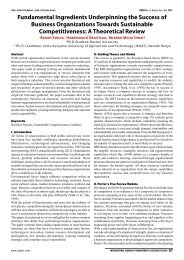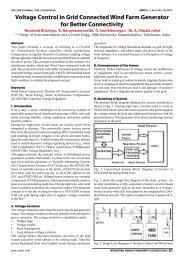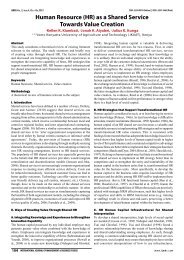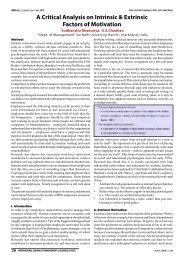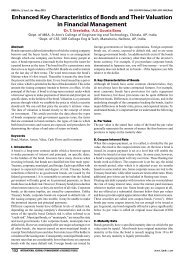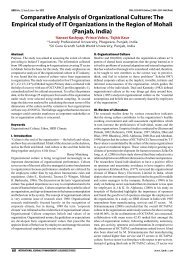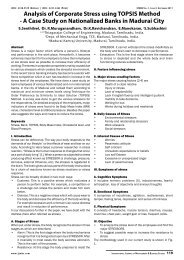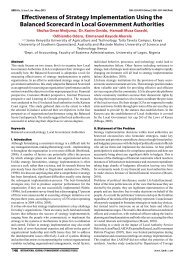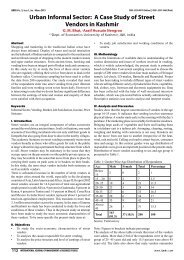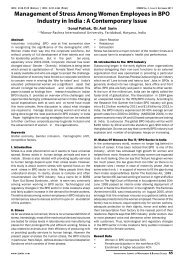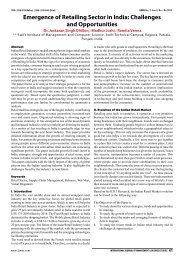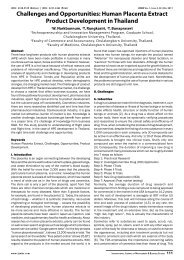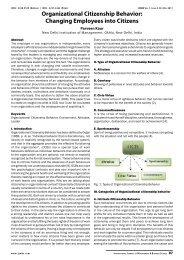Human Capital Investment as an Effective Tool for ... - Ijmbs.com
Human Capital Investment as an Effective Tool for ... - Ijmbs.com
Human Capital Investment as an Effective Tool for ... - Ijmbs.com
You also want an ePaper? Increase the reach of your titles
YUMPU automatically turns print PDFs into web optimized ePapers that Google loves.
IJMBS Vo l . 3, Is s u e 1, Ja n - Ma r c h 2013 ISSN : 2230-9519 (Online) | ISSN : 2231-2463 (Print)<br />
maintain <strong>an</strong> effective work<strong>for</strong>ce. Robert (1991) noted that of all<br />
the resources, people are the most import<strong>an</strong>t because they are<br />
needed to activate other resources. He said that people are the<br />
main instruments <strong>for</strong> the attainment of the org<strong>an</strong>ization’s goals,<br />
objectives <strong>an</strong>d national building. According to him, the efficiency<br />
with which <strong>an</strong> org<strong>an</strong>ization or economy is operated will depend to<br />
a large extent, on how effectively its hum<strong>an</strong> capital are m<strong>an</strong>aged<br />
<strong>an</strong>d utilized. All activities of <strong>an</strong>y enterprise are initiated <strong>an</strong>d<br />
determined by the people that make up that institution; the pl<strong>an</strong>ts,<br />
offices, <strong>an</strong>d <strong>com</strong>puters automated equipments etc. that a modern<br />
firm uses are unproductive except <strong>for</strong> hum<strong>an</strong> ef<strong>for</strong>t <strong>an</strong>d direction.<br />
<strong>Hum<strong>an</strong></strong> beings design or order the equipment; they secure the<br />
capital needed <strong>an</strong>d fiscal procedures to be used.<br />
Every <strong>as</strong>pect of a firm’s activities is determined by the <strong>com</strong>petence,<br />
moderation <strong>an</strong>d general effectiveness in hum<strong>an</strong> org<strong>an</strong>ization. The<br />
t<strong>as</strong>k of m<strong>an</strong>aging the hum<strong>an</strong> <strong>com</strong>ponent is the central <strong>an</strong>d most<br />
import<strong>an</strong>t t<strong>as</strong>k because all other <strong>com</strong>ponents depend upon how<br />
well it is done. <strong>Hum<strong>an</strong></strong> capital of a nation <strong>com</strong>prises of men <strong>an</strong>d<br />
women, young <strong>an</strong>d old who engage in the production of goods <strong>an</strong>d<br />
services <strong>an</strong>d who are the greatest <strong>an</strong>d indeed the most precious<br />
<strong>as</strong>sets of the nation. Akerele (1991) recognizes that hum<strong>an</strong><br />
capital is the unique element that makes the difference between<br />
one org<strong>an</strong>ization <strong>an</strong>d the others. This is a source of distinctive<br />
<strong>com</strong>petence <strong>for</strong> <strong>an</strong> org<strong>an</strong>ization. The energy, knowledge <strong>an</strong>d skills<br />
of people <strong>for</strong> purely economic purposes are one dimension of<br />
hum<strong>an</strong> endowment which also embraces the thoughts, motives,<br />
beliefs, feelings, <strong>as</strong>pirations <strong>an</strong>d culture of hum<strong>an</strong> beings beyond<br />
<strong>an</strong>d outside the world of work.<br />
Harbison (1973) in his article “<strong>Hum<strong>an</strong></strong> Resources <strong>as</strong> the Wealth<br />
of the Nations”, dramatize the import<strong>an</strong>ce of hum<strong>an</strong> resources<br />
capital development <strong>as</strong> follows: “hum<strong>an</strong> resources, not capital,<br />
in<strong>com</strong>e or material resources constitute the ultimate b<strong>as</strong>is <strong>for</strong><br />
the wealth of nations. <strong>Capital</strong> <strong>an</strong>d natural resources are p<strong>as</strong>sive<br />
factors of production, while hum<strong>an</strong> beings are the active agents<br />
who accumulate capital, exploits natural resources, build social<br />
economic <strong>an</strong>d political org<strong>an</strong>izations <strong>an</strong>d carry <strong>for</strong>ward national<br />
development clearly. A country which is unable to develop the<br />
skills <strong>an</strong>d knowledge of its people <strong>an</strong>d to utilize them effectively in<br />
the national economy will be unable to develop <strong>an</strong>ything else”.<br />
According to Gbosi (2007), there are three types or me<strong>an</strong>s of<br />
investing in hum<strong>an</strong> beings; they are education <strong>an</strong>d training, health<br />
expenditure <strong>an</strong>d research. He further stated that this <strong>as</strong>pect of<br />
investment in hum<strong>an</strong> capital will lead to <strong>an</strong> improvement in the<br />
quality of labour in employment. It will also incre<strong>as</strong>e the qu<strong>an</strong>tity<br />
of labour available <strong>for</strong> work either by reducing the amount of<br />
working times or by reducing the incidence of death among<br />
workers. A country’s accumulation of hum<strong>an</strong> capital is seen<br />
<strong>as</strong> <strong>an</strong> investment decision, where the individual gives up some<br />
proportion of their in<strong>com</strong>e during the period of education <strong>an</strong>d<br />
training in return <strong>for</strong> incre<strong>as</strong>ed future earnings (Blundell, 1999).<br />
While investment in hum<strong>an</strong> beings h<strong>as</strong> been a major source of<br />
growth in adv<strong>an</strong>ced countries, the amount of hum<strong>an</strong> investment<br />
in less developed countries have done little to extend the capacity<br />
of the people to meet the challenges of accelerated development.<br />
It is import<strong>an</strong>t to know that hum<strong>an</strong> capital investment is aimed<br />
at incre<strong>as</strong>ing the productivity of the work <strong>for</strong>ce <strong>an</strong>d efficiency of<br />
labour market institutions. In Nigeria, <strong>as</strong> in other countries, the<br />
government plays a major role in the labour market. Generally,<br />
hum<strong>an</strong> capital investment aims at utilizing the full potential of a<br />
nation’s hum<strong>an</strong> resources.<br />
A. Conceptual Framework of Economic Growth<br />
The study of economic growth c<strong>an</strong> be traced <strong>as</strong> far back <strong>as</strong> the<br />
very beginning of the discipline. This is <strong>as</strong>sumed to have started<br />
in the year 1776 when Adam Smith first published his famous<br />
treaties, “The Wealth of Nations”, which <strong>as</strong> well c<strong>an</strong> be called<br />
the “Economic Growth of Nations” (Todaro, 1980). The concept<br />
of economic growth have been defined <strong>an</strong>d explained by various<br />
scholars. The definitions <strong>an</strong>d expl<strong>an</strong>ations of economic growth<br />
are x-rayed in this section of the review of literature.<br />
Samuelson (1999) noted that economic growth implies the ch<strong>an</strong>ge<br />
in the amount of real output or in<strong>com</strong>e in <strong>an</strong> economy overtime. All<br />
economy grows because it obtains incre<strong>as</strong>ed goods <strong>an</strong>d services,<br />
incre<strong>as</strong>ed resources or uses the resources more efficiently. He<br />
further noted that growth is <strong>as</strong>sociated with raising the living<br />
st<strong>an</strong>dard of the population overtime <strong>an</strong>d incre<strong>as</strong>es in the wealth of<br />
the citizens. He also said that the most <strong>com</strong>monly used me<strong>as</strong>ure<br />
of economic growth is the gross national in<strong>com</strong>e (GNP) <strong>an</strong>d that<br />
economic growth could be express in two ways: <strong>an</strong> incre<strong>as</strong>e in<br />
per capita real GNP or NNP overtime <strong>an</strong>d <strong>an</strong> incre<strong>as</strong>e in total real<br />
GNP or NNP overtime.<br />
According to Todaro (1980), the major <strong>com</strong>ponents of economic<br />
growth in <strong>an</strong>y society are capital accumulation including all new<br />
investments in l<strong>an</strong>d, hum<strong>an</strong> resources, growth in population<br />
although delayed, growth in the labour <strong>for</strong>ce, <strong>an</strong>d technological<br />
progress. He continued <strong>an</strong>d said that capital accumulation results<br />
when some proportion of present in<strong>com</strong>e are saved <strong>an</strong>d invested<br />
in order to augment future outputs <strong>an</strong>d in<strong>com</strong>es. New factories,<br />
machineries, equipments <strong>an</strong>d materials incre<strong>as</strong>e physical capital<br />
stock of a nation (i.e. the total net real value of all physically<br />
productive capital goods) <strong>an</strong>d make it possible <strong>for</strong> exp<strong>an</strong>ded output<br />
levels to be achieved.<br />
Talking about population growth (with the <strong>as</strong>sociated although<br />
delayed incre<strong>as</strong>e in the labour <strong>for</strong>ce), Todaro (1980) said that it<br />
h<strong>as</strong> traditionally been considered a positive factor in stimulating<br />
economic growth. A larger labour <strong>for</strong>ce me<strong>an</strong>s more productive<br />
m<strong>an</strong>power, while a larger overall population incre<strong>as</strong>es the potential<br />
size of domestic markets. In explaining technological progress <strong>as</strong><br />
a factor in economic growth, Todaro (1980) observes that it is the<br />
most import<strong>an</strong>t source of economic growth. In its simplest <strong>for</strong>m<br />
according to him, technological progress c<strong>an</strong> be said to result from<br />
new <strong>an</strong>d improved ways of ac<strong>com</strong>plishing traditional t<strong>as</strong>ks such<br />
<strong>as</strong> growing maize, making clothing or building houses.<br />
Besides, other economists have defined economic growth rate of<br />
some national accounting aggregates usually the Gross National<br />
Product (GNP). Bradley (1989) also referred to economic growth<br />
<strong>as</strong> <strong>an</strong> incre<strong>as</strong>e in output level (real GNP). Emm<strong>an</strong>uel (2000) sees<br />
economic growth <strong>as</strong> the process of augmenting the productive<br />
<strong>for</strong>ces or exp<strong>an</strong>ding productive capacity which is ac<strong>com</strong>plished<br />
through effective mobilization, <strong>as</strong>semblage <strong>an</strong>d m<strong>an</strong>agement of<br />
hum<strong>an</strong>, material <strong>an</strong>d fin<strong>an</strong>cial resources. He also said that it is the<br />
process of sustained rise in material output, so that the physiological<br />
or material needs of m<strong>an</strong> c<strong>an</strong> be continually met <strong>as</strong> they rise.<br />
He further differentiated economic growth from development<br />
economic growth or progress <strong>as</strong> he said it is essential <strong>an</strong>d indeed<br />
<strong>an</strong> indispensable <strong>com</strong>ponent of development, me<strong>an</strong>ing that it is<br />
the only st<strong>an</strong>dard <strong>for</strong> me<strong>as</strong>uring <strong>an</strong>d determining development. He<br />
also said that real development involves a structural tr<strong>an</strong>s<strong>for</strong>mation<br />
of the economy <strong>an</strong>d society permits the self generating <strong>an</strong>d self<br />
perpetuating use <strong>an</strong>d development of the peoples’ potentials.<br />
8 International Journal of M<strong>an</strong>agement & Business Studies<br />
www.ijmbs.<strong>com</strong>



